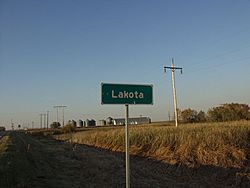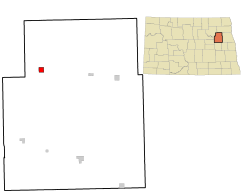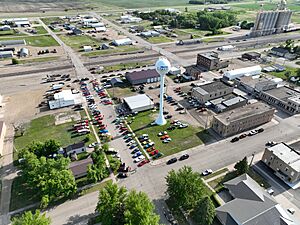Lakota, North Dakota facts for kids
Quick facts for kids
Lakota, North Dakota
|
|
|---|---|

Lakota, North Dakota
|
|

Location of Lakota, North Dakota
|
|
| Country | United States |
| State | North Dakota |
| County | Nelson |
| Founded | 1883 |
| Area | |
| • Total | 1.00 sq mi (2.59 km2) |
| • Land | 1.00 sq mi (2.59 km2) |
| • Water | 0.00 sq mi (0.00 km2) |
| Elevation | 1,522 ft (464 m) |
| Population
(2020)
|
|
| • Total | 683 |
| • Estimate
(2022)
|
683 |
| • Density | 683.68/sq mi (264.00/km2) |
| Time zone | UTC-6 (Central (CST)) |
| • Summer (DST) | UTC-5 (CDT) |
| ZIP code |
58344
|
| Area code(s) | 701 |
| FIPS code | 38-44300 |
| GNIS feature ID | 1036113 |
Lakota is a small city in Nelson County, North Dakota, in the United States. It is the main town, or county seat, of Nelson County. This means it's where the county government offices are located.
Lakota is about 63 miles west of Grand Forks and 27 miles east of Devils Lake. In 2020, about 683 people lived there. This makes Lakota the 76th-largest city in North Dakota.
Contents
Lakota's Location and Weather
Lakota covers about 1 square mile of land. It does not have any large bodies of water within its city limits.
Like most of North Dakota, Lakota has a continental climate. This means it has very cold winters and warm summers. In January, the average low temperature is around 0 degrees Fahrenheit (or -18 degrees Celsius). In July and August, the average high temperature is about 79 degrees Fahrenheit (or 26 degrees Celsius).
Who Lives in Lakota?
| Historical population | |||
|---|---|---|---|
| Census | Pop. | %± | |
| 1890 | 227 | — | |
| 1900 | 576 | 153.7% | |
| 1910 | 1,023 | 77.6% | |
| 1920 | 959 | −6.3% | |
| 1930 | 860 | −10.3% | |
| 1940 | 907 | 5.5% | |
| 1950 | 1,032 | 13.8% | |
| 1960 | 1,066 | 3.3% | |
| 1970 | 964 | −9.6% | |
| 1980 | 963 | −0.1% | |
| 1990 | 898 | −6.7% | |
| 2000 | 781 | −13.0% | |
| 2010 | 672 | −14.0% | |
| 2020 | 683 | 1.6% | |
| 2022 (est.) | 683 | 1.6% | |
| U.S. Decennial Census 2020 Census |
|||
A Look at the 2010 Census
In 2010, there were 672 people living in Lakota. They lived in 338 households. Most of the people were White (about 96.7%). A small number were Native American (about 1.9%) or African American (about 0.3%).
About one-fifth of the households had children under 18. Many households were married couples living together. About 40% of all households were made up of just one person. Many of these were people aged 65 or older living alone.
The average age of people in Lakota was about 50 years old. About 19.5% of residents were under 18. About 28% were 65 years old or older. The number of males and females was almost equal.
Getting Around Lakota
The Amtrak Empire Builder train travels through Lakota. This train goes between Seattle/Portland and Chicago. However, the train does not stop in Lakota. The closest train station is in Devils Lake, which is about 27 miles away.
Famous People from Lakota
Some notable people have connections to Lakota:
- Charles Watson Boise: A well-known mining engineer.
- Asle Jorgenson Gronna: He served as a U.S. Senator for North Dakota.
- Rick Helling: A MLB pitcher who won a World Series championship.
See also
 In Spanish: Lakota (Dakota del Norte) para niños
In Spanish: Lakota (Dakota del Norte) para niños


